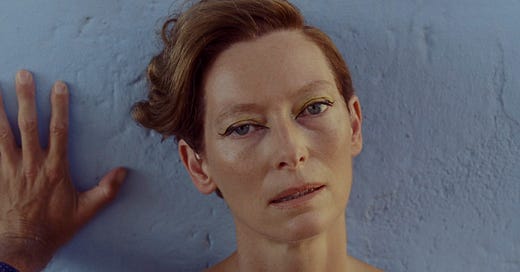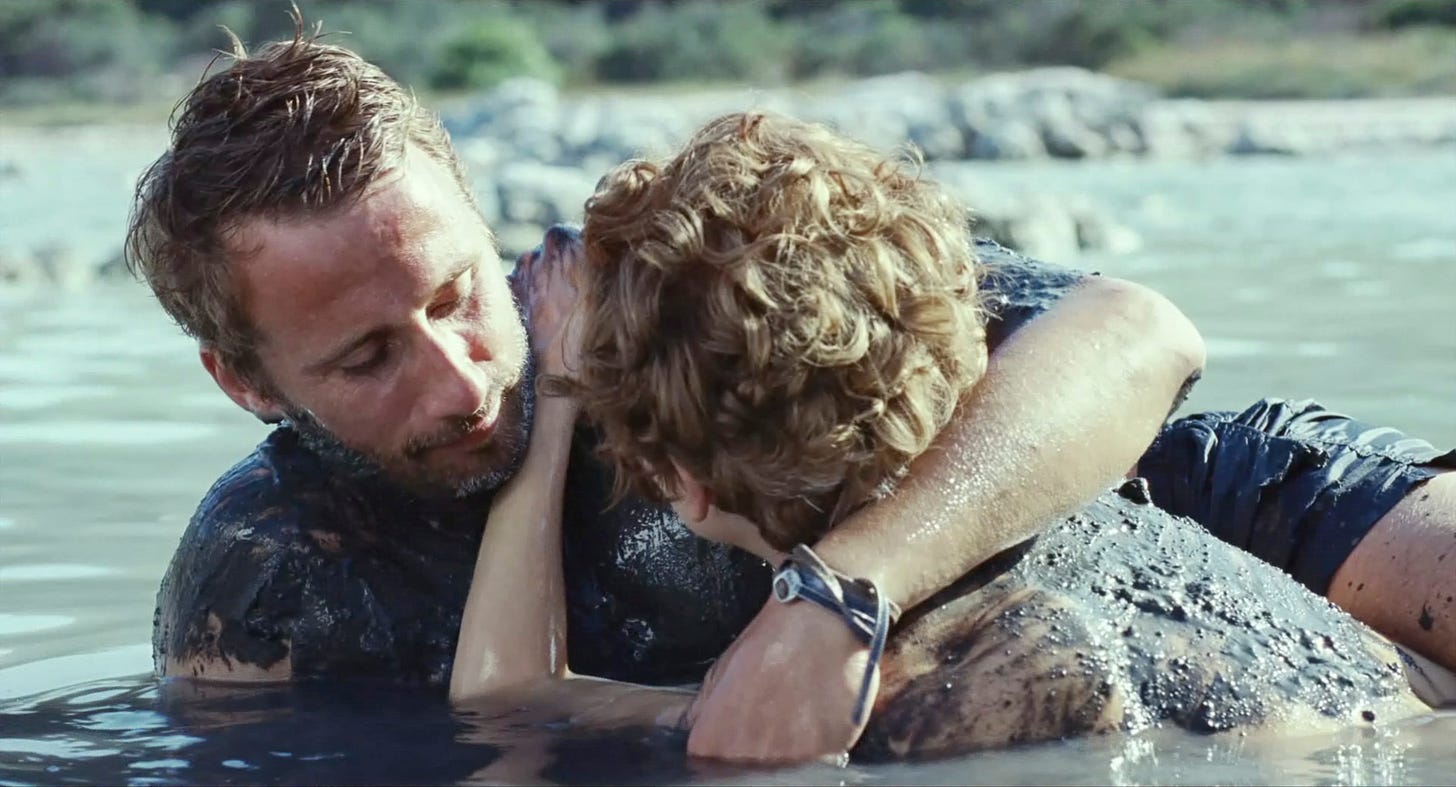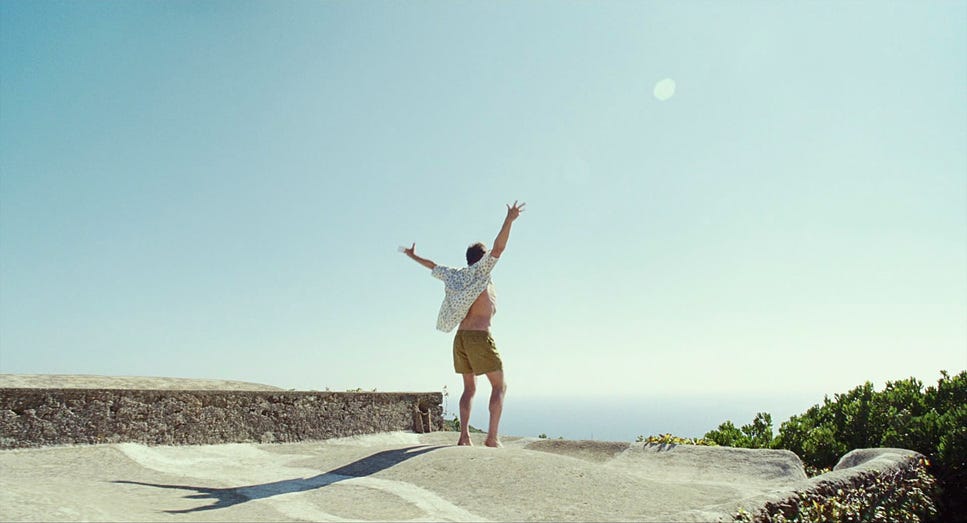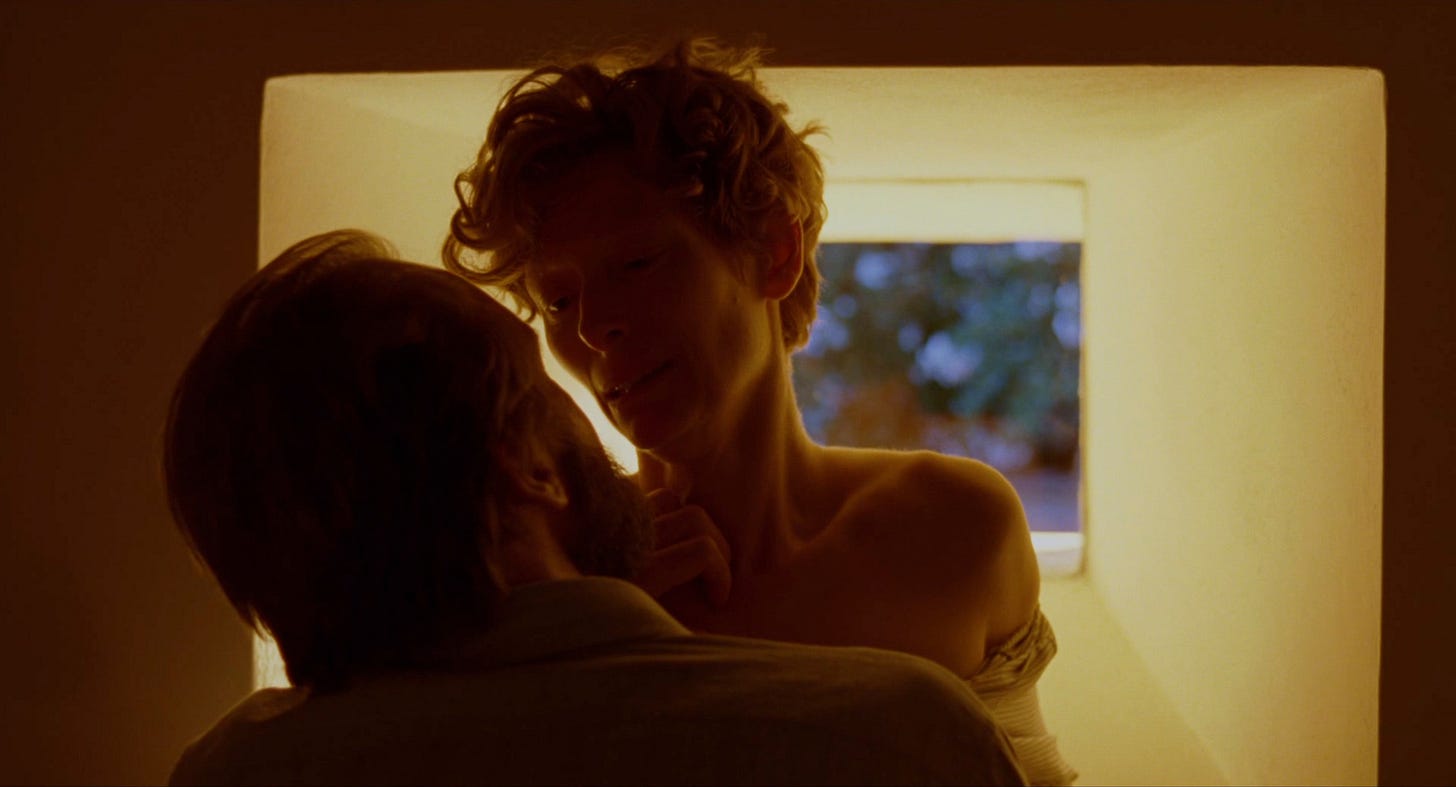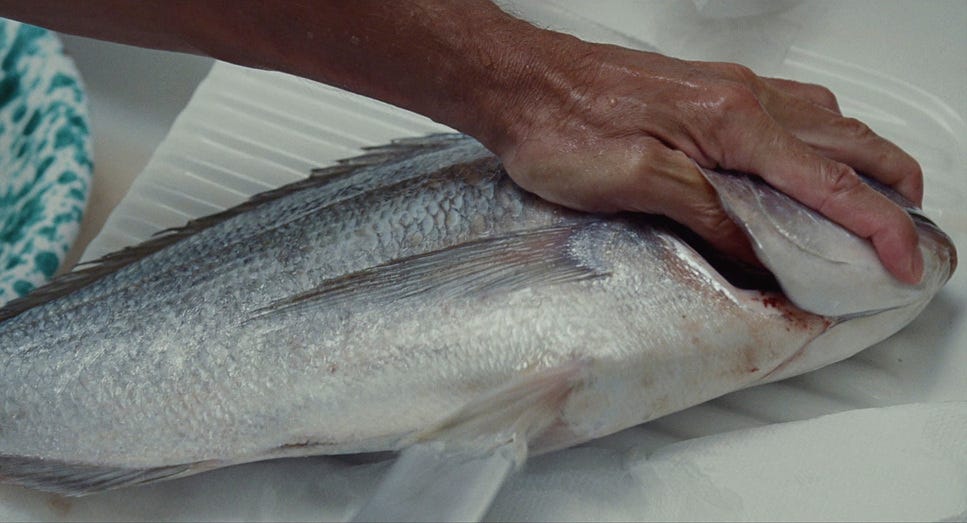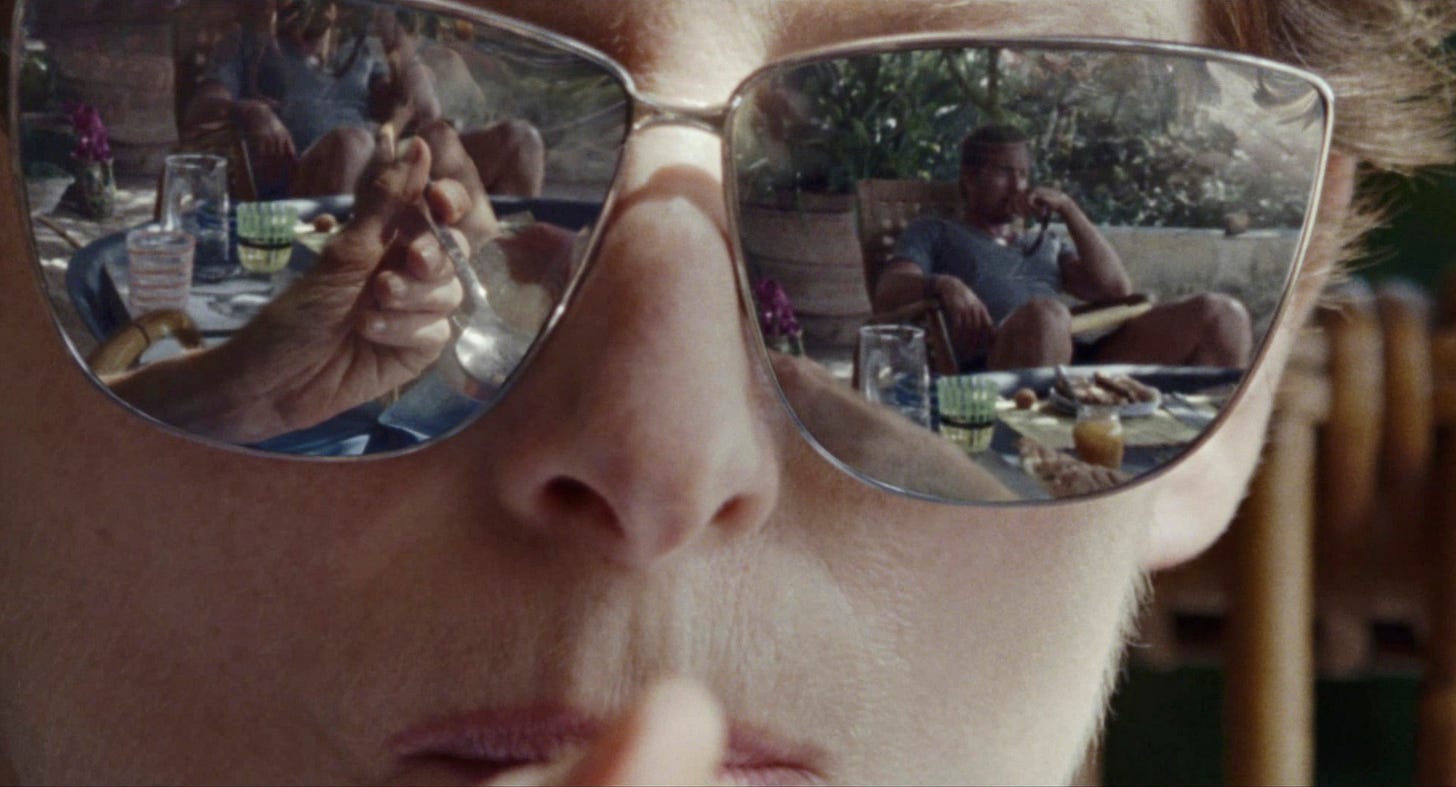NEVER CURSED VOL 5: A Bigger Splash
In Luca Guadagnino’s sexiest film, beauty is only skin deep
My favorite Luca Guadagnino film, 2015’s psychosexual thriller A Bigger Splash, is the messy European answer to the cold, American beauty of his recent courtside hit, Challengers. Sweat, obsession, and deception drive both films, but the sweat ladled onto A Bigger Splash’s beautiful cast is a byproduct of languishing poolside, rather than the result of the punishing American work ethic that drives Challengers. Bodies are beautiful, but bellies and thighs are allowed to be soft; magnetism comes from someplace other than perfection. Success affords adults the ability to behave like entitled children, inuring them from the desire for anything beyond the buffet of sex laid at their feet. The mountain of ambition has been scaled, and we’re invited to indulge in the view from the top before it all comes tumbling down. While Challengers is a film about young professionals forced into adult choices by the pressure of their careers, A Bigger Splash is a film about adult artists struggling to grow up after being coddled and insulated by success.
On the sun-bleached Mediterranean island of Pantelleria, many of the seeds of Guadagnino’s current style are just starting to take root: his giddy formal play, use of flashback to inform present dynamics, copious erotic culinary metaphors, and his love of smirking, sweat-drenched performance all feature prominently. But even in their more nascent stages, Guadagnino’s attitude towards these now-signature style elements feel absolutely precise, naturalistic, and emotionally rich.
In A Bigger Splash, stadium-filling rock star Marianne (Tilda Swinton) and her sober photographer boyfriend Paul (Mathias Schoenaerts) are hiding out on the rocky isle of Pantelleria while Marianne is on vocal rest after a surgery. The couple zips around the island, smearing mud on each other and making out in their gorgeous pool until a shadow (literally) passes over their Edenic retreat: their old friend Harry (Ralph Fiennes) and his daughter Penelope (Dakota Johnson) are crashing the party. Harry immediately needles and destabilizes the couple’s happiness, begging Marianne to break her medically-recommended silence and ordering daiquiris for the sober Paul. In Harry’s eyes, their life in the wilds of Pantelleria is the rock and roll equivalent of a mortgage in Connecticut, replete with the bourgeois signifiers of swimming pool, practical car*1, and hired help.
Via two brief flashbacks, we learn that Harry and Marianne were once lovers and colleagues, before they split and Harry set Marianne up with Paul. As in Challengers, Guadagnino uses flashback in A Bigger Splash to explain present tensions between lovers and friends, but with a completely different effect. The meat of Challengers’ drama lives primarily in flashback (culminating to one crucial on-court decision in the present), while flashback in A Bigger Splash is used sparingly to sketch out the details of who characters were before they shed their old identities; the drama remains squarely in the present. While Paul and Marianne desperately tread water in the present, trying to reinvent themselves as tempered, responsible adults (in Marianne’s case literally stepping into her late mother’s shoes), Harry is desperate to drag them back under into their chaotic, nostalgic past. Nostalgia is shown to be the enemy of reinvention. In Challengers, Guadagnino generates tension through an insistent, unpredictable pattern of narrative interruption, engaging the audience as we try to unravel what past events are being hidden from us. A Bigger Splash languidly seduces its audience, using flashback to momentarily immerse the viewer in a steamy, shallow pool of nostalgia before wrenching us back into the present to discover we’ve drifted far from solid ground.
Back in the present on Pantelleria, Guadagnino sets to work picking apart Marianne and Paul’s illusory, consequence-free contentment. Between Harry’s loud meddling and Penelope’s watchful needling, we soon learn that Paul is recovering from a stay in rehab following a suicide attempt. Fiennes’ deft manipulation recalls the machinations of another cinematic “Harry”: Danny Glover’s guest from hell in Charles Burnett’s To Sleep with Anger. The two men compete over Marianne’s attention as Penelope observes from the sidelines, craving a crumb of adult recognition.
As in Challengers, the relationship between the two men can feel more vibrant than their relations with the woman they’re ostensibly fighting over. They wrestle and cajole each other, and Guadagnino blocks them with the sense that each move they make is a carefully choreographed counter-move. Fiennes is at a career best, swinging from a subtle look of pain and insecurity at Marianne and Paul curled together on the couch to a bravura lipsync to the Rolling Stones’ “Emotional Rescue.” As we chase Harry across the rooftop into the sun, Guadagnino and DP Yorick Le Saux achieve a moment of cinematic ecstasy with nothing more than a man, a camera, and a tasteful lens flare. The scene is decadent, wincingly funny, and oddly seductive, the highpoint of the love triangle’s careful machinations and one of my favorite images in Luca Guadagnino’s filmography.
But the tacit detente between the two men can only last so long. Appetites begin to stir beneath the veneer of contentment. A pulse jumps in sweaty close up, betraying the languid pose of a body at rest. Swinton plays this turn beautifully, coaxed into haltingly voicing her real desires. David Kajganich’s script rises to the challenge of communicating the precarity of Marianne’s happiness without the crutch of dialogue (just as Justin Kuritzkes’ script for Challengers deftly communicates emotional revelations through the dialogue-less tennis scenes). As tension mounts, the onscreen metaphors are overt and delicious: a snake slithers into an Edenic poolside garden as Harry & Penelope arrive; a thick salt crust is hammered off the tender flesh of a fish as Marianne’s defenses start to crumble under Harry’s insistent passes; Paul cages Marianne in a demure beige dress, or, as Harry would say, putting a “bell around [her] neck.”
As tensions build and the angles of our love triangle sharpen, A Bigger Splash takes a turn to “moody Mediterranean-noir,” as Justin Chang wrote in his LA Times review. Johnson’s character complicates this geometry as a sort of audience surrogate, goading the characters into the disastrous cathartic action we can’t help but hope for. If Challengers’ tennis audience is expected to spectate passively as Guadagnino teasingly denies them release via almost Brechtian interruptions in the narrative and score, A Bigger Splash encourages indulgence, participation, and identification up until the moment Guadagnino slyly twists the knife. Just as Harry and Penelope’s maneuvering starts to bear destructive fruit, screenwriter Kajganich widens the scope of the film and our characters’ cloistered melodrama tips into socially-conscious tragedy. When disaster inevitably strikes, our characters’ island paradise is revealed to be more of a hostile prison than a Dionysian playground. Here, Guadagnino and screenwriter Kajganich are both at their most skillful, beguiling the audience with the psychodramas of the rich and beautiful in order to shine a cold light on some of the most explicit and successful social commentary in Guadagnino’s filmography.
Guadagnino is a filmmaker who delights in using his camera to describe material beauty, but he excels when he plunges a hand beneath the manicured surface to reveal something thorny and rotten. The virtue signaling of Harry’s fading hammer-and-sickle tattoo and Marianne’s demure rejection of the power of her own voice and celebrity are challenged when the real world comes knocking. Challengers and A Bigger Splash are both cinematic delicacies, but only A Bigger Splash is honest and daring enough to make us lose our appetite.
WATCH LIST
“Beautiful people having a bad time on holiday” is admittedly one of my favorite genres – here are some of my picks, please let me know yours!
NEEDLE DROPS
Luca Guadagnino wields a needle drop like a weapon. Here’s my playlist for driving around hairpin Mediterranean turns.
*for tooling around a windswept island with your lover – it’s all relative.


